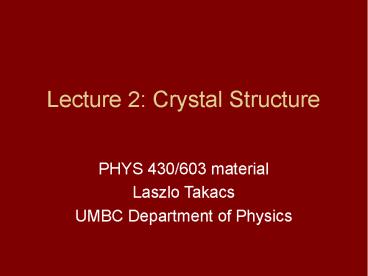Lecture 2: Crystal Structure - PowerPoint PPT Presentation
Title:
Lecture 2: Crystal Structure
Description:
Lecture 2: Crystal Structure PHYS 430/603 material Laszlo Takacs UMBC Department of Physics Unless we specify otherwise, solid means crystalline, at least ... – PowerPoint PPT presentation
Number of Views:431
Avg rating:3.0/5.0
Title: Lecture 2: Crystal Structure
1
Lecture 2 Crystal Structure
- PHYS 430/603 material
- Laszlo Takacs
- UMBC Department of Physics
2
Unless we specify otherwise, solid means
crystalline, at least on the microscopic scale
- Short range structure reflects the nature of
bonds, but the crystal structure also has to
conform to translational symmetry - If we shift the crystal by certain vectors of
translation, T, every atom moves into the
position of an identical atom. - The possible vectors of translation are linear
combinations with integer coefficients of three
primitive translational vectors - T na mb pc
- The entire structure can be described by a unit
cell defined as a parallelepiped defined by a,
b, c and its repeated translations by a, b, c.
There can be symmetries beyond translation. - A smallest possible unit cell is the primitive
cell. - The points in a lattice are mathematical points,
we get the crystal structure by putting identical
groups of atoms - the basis - on each lattice
point. In simple cases, the basis is a single
atom.
3
The elementary vectors of translation, i.e. the
unit vectors of our coordinate system
4
Find the unit cell
Maurits Cornelis Escher
5
Unit cell and symmetries
6
Crystal - glass
7
The fourteen Bravais lattices
8
Unit cells of the fcc structure
9
Interstitial sites in fcc structure
10
The hcp structure and its unit cell
11
Interstitial sites in hcp structure
12
Interstitial sites in bcc structure
13
CsCl (B2) structure
14
Packing based on hexagonal structure AlB2 and WC































